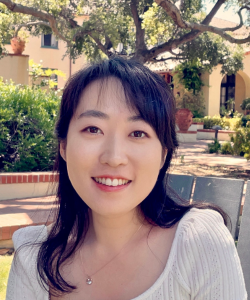Dr. Eunji Choi is an assistant professor of population health sciences in the Division of Epidemiology. Before joining Weill Cornell Medicine (WCM) she was an instructor at the Stanford University School of Medicine.
Tell us about your research.
I currently specialize in lung cancer research. I aim to advance cancer disparity research that accounts for gender, race, income, education, and other neighborhood-level social determinants of health. These all impact the early detection of cancer, cancer outcomes, and aging acceleration.

Dr. Eunji Choi
Several landmark lung cancer screening trials showed that lung cancer screening with low-dose computed tomography can reduce lung cancer-specific mortality by 20 percent. However, screening participation rates in the US fall below 20 percent, and there are significant disparities in screening rates based on gender and race. I am currently investigating how we can reduce those disparities and make screening both equitable and efficient.
Additionally, due to improvements in early detection and therapeutic techniques, the number of lung cancer survivors is rapidly increasing, but these survivors are at risk of developing recurrence or new cancer. As such, I am developing risk prediction models using dynamic frameworks to incorporate longitudinal patient data into risk prediction. These help determine which patients are more likely to develop recurrence or new cancer and can suggest post-treatment surveillance strategies based on risk levels.
I am also studying how we can measure clinical aging using various electronic health records (EHR) and medical claims data to determine what factors accelerate clinical aging in cancer survivors. I am excited to continue this work and branch into other types of cancer research.
What expertise do you bring to the role?
In my research, I use lung cancer epidemiology to bridge data science and clinical epidemiology, thereby improving translational studies. I have significant experience using various types of cancer data, including registries, epidemiologic cohorts, claims-based databases, and biobanks. I also have experience curating information embedded in EHR data over lengthy periods of patient follow-up. My experience with data management allows me to use dynamic risk prediction models that capture longitudinal changes in risk profiles per patient, thus providing updated predicted risk scores over time. I can also use target trial emulation methods to emulate a hypothetical clinical trial with observational data. This framework reduces various biases from observational study design and approximates causal estimates that we may obtain from a well-controlled clinical trial.
In previous research, I’ve worked towards proposing more equitable forms of lung cancer screening strategy. For example, the PLCOm2012 model is a widely used lung cancer risk prediction model. Lung cancer screening based on individual risk predicted via the PLCOm2012 model is very efficient. However, the model was first developed using a predominantly white population, thus unintentionally causing disparities in screening eligibility and performance among racial minorities. As such, I recalibrated the PLCOm2012 model (PLCOm2012update) using large multiethnic population-based data. The updated model helps effectively reduce racial disparities in lung cancer screening performance across all major racial/ethnic groups in the US.
What brings you to Weill Cornell Medicine?
The diverse patient population that we serve in NYC is one of the main reasons I chose Weill Cornell Medicine (WCM). Following WCM’s dedication to providing high-quality care to patient populations, I want to cultivate meaningful cancer research and collaborate across the Meyer Cancer Center, various Cornell campuses, and other institutions across NYC. Additionally, the Department of Population Health Sciences and the Division of Epidemiology are expanding, both in numbers and the breadth of epidemiological, translational, and population-based research they conduct. I am excited to grow and collaborate with colleagues both within and outside my division.
Are there any trends or issues you are currently following in your field?
As a lung cancer epidemiologist, I have tracked the growing concern around lung cancer among never-smokers. Given that smoking is a very significant risk factor for lung cancer, most lung cancer studies or screening programs focus on lung cancer among ever-smokers. However, a quarter of patients develop lung cancer without a smoking history, especially among Asian women. Risk factors such as family history, exposure to cooking fumes, and air pollution have been identified. However, further research is required to determine more risk factors, how we can detect them early on, and whether lung cancer screening would be meaningfully effective for reducing lung cancer-specific mortality among never-smokers.
Also, as the rapidly growing amount of EHR data continues to provide rich longitudinal patient information, the need for dynamic risk modeling increases. There are two popular dynamic predictive risk modeling methods: the joint model and the landmark model. While the landmark model is simplified to create useful predictions, it hasn’t yet been used for competing risk or penalized regression. Given my expertise, I’m finding ways to improve the landmark model for myself and other epidemiological and clinical researchers.
Finally, I am always working to accurately and comprehensively capture information in EHR, which can be strenuous work involving human annotation and validation. As such, I am exploring how we can use the potential of generative AI to ease that burden.
- Highlights

